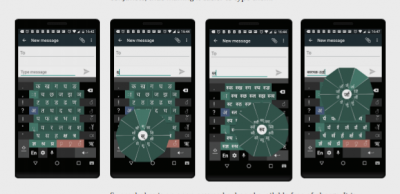
Text input in Indian languages on mobile phones has many challenges. Not surprisingly, text input on computers and mobile devices in India is still predominantly in English. But only a small minority of Indians can read or write in English. This is a major barrier in the wider adoption of digital technologies by such users. Our research aims at designing easy-to-use text input mechanism sto enable Indians to type in their mother tongue.
One of our designs is called Swarachakra (स्वरचक्र), a keyboard for typing in Indic scripts on Android. It is available for Asomiya, Bengali, Gujarati, Hindi, Kannada, Konkani, Malayalam, Marathi, Odia, Punjabi, Tamil and Telugu. As of February 2018, Swarachakra has been downloaded by more than 30 lakh users of these languages.
The design of Swarachakra is based on the structure of each script. It groups consonants phonetically in a grid similar to those found in school textbooks. When the user touches a consonant, Swarachakra displays a wheel (chakra) of vowel modifiers (swaras) around the finger. The user slides his finger in the direction of the desired vowel modifier. With practice, the task of selecting a consonant and a vowel modifier quickly becomes a single gesture. Typing conjuncts is particularly hard in Indian scripts. Swarachakra provides shortcuts for the frequently used conjuncts and previews while typing other conjuncts, thus making it easier to type them.
Swarachakra is an open-source keyboard available free of charge. It is supported by voluntary efforts of a team of collaborators for each language. The total number of volunteers contributing to Swarachakra now exceeds 80. Hindi, Marathi, Kannada and Konkani versions of Swarachakra have integrated a ‘remote keyboard’ mode, developed in collaboration with FIT
Prof. A N Joshi
